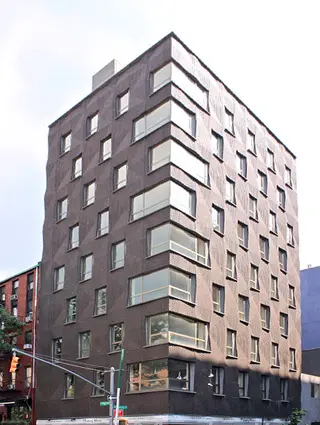 Carter Horsley
Carter HorsleyDec 23, 2011
Carter's Review
This very distinctive, 12-story rental apartment building at 290 Mulberry Street on the southeast corner at Houston Street in NoLiTa was designed by SHoP Architects in 2008 but not completed until 2012.
It is notable for its wavy brown-brick façades and its prominent location across Mulberry Street from the very famous Puck Building, a luxury condominium building with two large sculptures on its façades of Puck, the Shakespearian character who was the “mascot” of a humor magazine of the same name.
The project was initiated by Cardinal Real Estate Investments, headed by Trevor Stahelski and Kyle Ransford, as a condominium but was converted to a rental project by Karass Development, which is headed by Vladimir Kokorev whose father is a Russian shipping magnate, according to July 5, 2013 article in The New York Times by C. J. Hughes.
The project is known now as Mulberry House.
It is also known as 41 East Houston Street and it has very large alternate corner windows and only 8 apartments.
The building replaced the Houston Village Farm Deli, a three-story structure, and an adjacent lot to the east.
SHoP Architects is best known for The Porter House, a 10-story condominium development at 66 Ninth Avenue noted by its irregular fenestration and façade illumination pattern that dominates the north end of the Meatpacking District and is one of the most interesting combinations of old and new architecture in the city. SHoP is also involved now in several major projects including the 1,400-foot-high residential tower at 111 West 57th Street, the Domino Sugar riverfront development in Williamsburg, Brooklyn and the Barclays Center in Brooklyn.
The architects provided the following commentary at Archdaily about the building’s design:
“Making a literal interpretation of code written for classic ornamentation allowed us to project our enclosure over the property line at 10 percent intervals for every 100 square feet. Maximizing the amount of projected area, while minimizing the overall depth of the enclosure became key criteria for our design. When coupled with material properties and fabrication constraints, these criteria began to define an approach that was a contemporary reinterpretation of brick detailing. By customizing a standard precast brick panel system, we were able to achieve maximum effect a minimum cost. The building then becomes veiled by a textured wrapper around the street walls in contrast with the simplicity of the inner core.”
An article in the May 2001 edition of Metropolis magazine observed that “You might know that the firm's organizational chart essentially doubles as a family tree, given that SHoP was founded by twin brothers, the wife of one of them, and another married couple--all of whom met at Columbia University in the early 1990s….Like a few other partnerships made up of architects in their thirties, SHoP has a breezy collective title. An acronym cobbled together from the partners' last names, it combines the S in William and Christopher Sharples, 37-year-old identical twins, and Coren Sharples, 35, who is William's wife; the H in Kimberly Holden, 34; and the P in Gregg Pasquarelli, 35, Holden's husband. The SHoP name is also meant to suggest that despite the firm's command of technology it wants to maintain an explicit connection to tactile reality.”
A December 21, 2011 article by Amanda Fung at crainsnewyork.com noted that the project was sold for $25 million and that its original construction team would remain involved in completing the project as a rental then about 90 percent complete.
“The project ran into trouble in the wake of Lehman Brothers collapse in late 2008,” the article continued, adding that “The project's lender CIT Group attempted to foreclose on the building, but it fell into bankruptcy itself, according to published reports.” The developer said that CIT stopped funding the project and countersued the lender but the litigation was finally settled and the property was being delivered to the new owner without liens.
Bottom Line
Despite a troubled and stalled construction history, this building became a notable neighbor to its very famous neighbor across Mulberry Street, the Puck Building with its rainbow-lighting during marketing and its two undulating brick-panel façades.
Description
Despite a troubled and stalled construction history, this building became a notable neighbor to its very famous neighbor across Mulberry Street, the Puck Building with its rainbow-lighting during marketing and its two undulating brick-panel façades.
Amenities
The building has a full-time lobby attendant, a white-marble lobby, a second-floor terrace and storage units.
Apartments
Apartments have private elevator keys, radiant-heat Walnut flooring, security camera systems, central air-conditioning and double-glazed windows.
Kitchens have gloss-white cabinetry with stone countertops, Bosch cooktops and ovens, Miele dishwashers, Marvel wine coolers, and Liebherr stainless steel refrigerators.
The triplex penthouse had 2,613-square feet of interior space and its wrap-around terraces on the lower two floors and a 37-foot-long terrace on the 12th floor.
The 6th floor unit had two bedrooms with a 38-foot-long living/dining room with an open 17-foot-long kitchen with an island and a 12-foot-wide terrace off the 20-foot-wide entry foyer.
The full-floor, three-bedroom units on the 4th, 6th and 8th floors have long entry foyers with 13-foot-wide balconies and a 26-foot-wide living/dining room with an open kitchen with an island.

- Rental built in 2013
- Located in NoLiTa/Little Italy
- 8 total apartments 8 total apartments
- Doorman
 6sqft delivers the latest on real estate, architecture, and design, straight from New York City.
6sqft delivers the latest on real estate, architecture, and design, straight from New York City.
